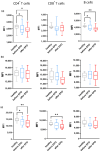Erythropoietin Effect on Complement Activation in Chronic Kidney Disease
- PMID: 39200211
- PMCID: PMC11351309
- DOI: 10.3390/biomedicines12081746
Erythropoietin Effect on Complement Activation in Chronic Kidney Disease
Abstract
The complement system is an important part of innate immunity. Despite its known protective role, the complement system may contribute to increased inflammation and tissue injury in cases where its balanced activation is disrupted. The kidneys have been shown to be largely affected by complement dysregulation. The aim of the present study was to investigate the effect of erythropoietin administration, on the complement system, in chronic kidney disease patients. The study involved 20 patients with CKD who received erythropoietin and measurements of levels of complement factors C3a and C5a and complement regulatory proteins (CregPs) CD55, CD46, and CD59. An increase in serum C3a and C5a levels was observed in response to EPO therapy. The increase in C3a was statistically significant (p < 0.05) and concurrent with a statistically significant decrease in CD55 in CD4+ T cells (p < 0.05) and B cells (p < 0.05) and CD59 levels in CD4+ and CD8+ T cells (p < 0.05) at completion of EPO therapy compared with healthy controls. The above observations demonstrate that EPO induces complement activation in patients undergoing EPO therapy with a simultaneous restriction of CRegPs expression, thus possibly allowing the uncontrolled complement activation, which may contribute to tissue injury and disease progression.
Keywords: chronic kidney disease; complement; erythropoietin; lymphocytes.
Conflict of interest statement
The authors declare no conflicts of interest.
Figures




References
LinkOut - more resources
Full Text Sources
Research Materials
Miscellaneous

